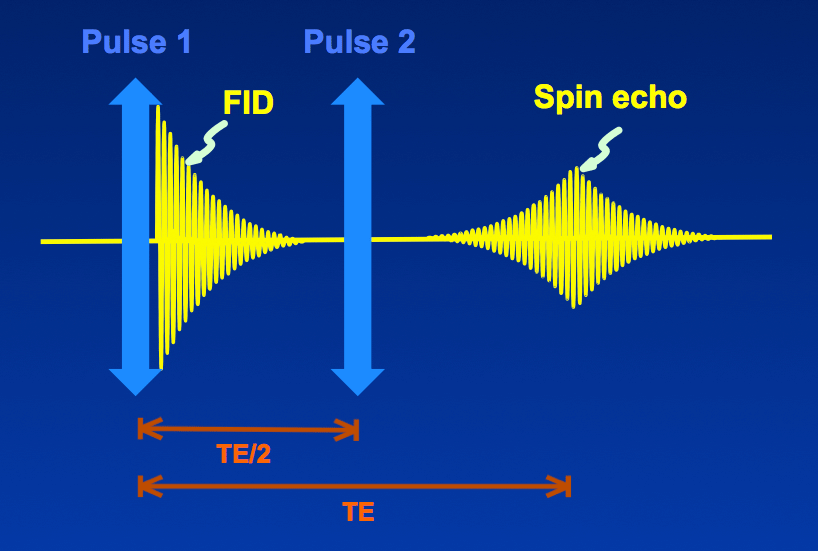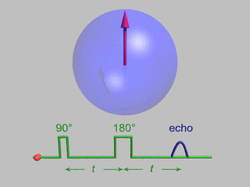|
A single RF pulse generates a free induction decay (FID), but two successive RF pulses produce a spin echo (SE). The time between the middle of the first RF pulse and the peak of the spin echo is called the echo time (TE).
This remarkable discovery was made in 1949 by Erwin Hahn and can be counted among the most important developments in the history of NMR. But where does the SE come from? |
 Erwin Hahn (1921-2016)
Erwin Hahn (1921-2016)
The SE represents regeneration of spin phase information apparently lost during the decay of the FID. The "rebirth" of the FID as a SE is possible because many of the T2* processes which originally produced the decay of the FID are symmetrically reversible. In fact, most of the FID signal has not been destroyed; it has merely become "disorganized" because the individual spins comprising it have lost their phase coherence. The system is said to possess a "hidden order" or "atomic memory". By applying a second RF pulse, certain dephased components of the original FID can be refocused into a SE.
The animation below shows how a spin echo is formed. The red arrows represent groups of spins that experience identical local fields and respond similarly. (Such groups of like-behaving spins are called spin isochromats, literally "spins of the same color".)
|
The 90°-pulse first tips these spins into the transverse plane. Because the local microscopic fields may differ slightly, some spin groups may precess faster (and gain phase) relative to others. This is represented by the spreading out of arrows in the transverse plane. The faster spins initially rotate toward the viewer and the slower spins rotate away. |
The 180°-pulse now turns the entire system on its head. An analogy to "flipping a pancake" is sometimes made. After the flip, the faster precessing spins now find themselves at the back of the pack. With continued evolution they eventually catch up with the slower spins. This occurs at time TE = 2 x t which is the center of the spin echo. Beyond the echo center the faster spins once again leave the slower ones behind and the system again dephases.
Although the example above shows the generation of spin echoes by successive 90° and 180° pulses, these precise flip angles are not required. In fact, spin echoes are formed when two successive RF-pulses of any flip angle are employed! Hahn, in his original paper, used two 90° pulses. When flip angles other than 90° and 180° are employed, the resultant spin echo is sometimes referred to as a Hahn echo.
Advanced Discussion (show/hide)»
No supplementary material yet. Check back soon!
References
Brewer RG, Hahn EL. Atomic memory. Sci Amer 1984:251(6):50-57.
Feinberg DA. The transformative genius of Erwin Hahn. Magnetic Resonance in Medicine Highlights, May 2016; pp. 2-9. (an interview of the 95-year-old Dr. Hahn shortly before his death loaded with interesting insights about his discoveries and the early days of NMR)
Hahn EL. Spin echoes. Phys Rev 1950;80:580-594.
"Spin Echo". Wikipedia. The Free Encyclopedia.
Brewer RG, Hahn EL. Atomic memory. Sci Amer 1984:251(6):50-57.
Feinberg DA. The transformative genius of Erwin Hahn. Magnetic Resonance in Medicine Highlights, May 2016; pp. 2-9. (an interview of the 95-year-old Dr. Hahn shortly before his death loaded with interesting insights about his discoveries and the early days of NMR)
Hahn EL. Spin echoes. Phys Rev 1950;80:580-594.
"Spin Echo". Wikipedia. The Free Encyclopedia.
Related Questions
Where does the MR signal come from?
What is the difference between spin echo, multi-spin echo and fast spin echo?
Where does the MR signal come from?
What is the difference between spin echo, multi-spin echo and fast spin echo?


